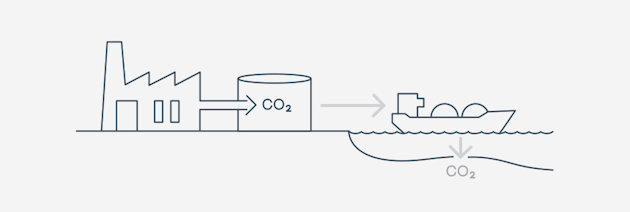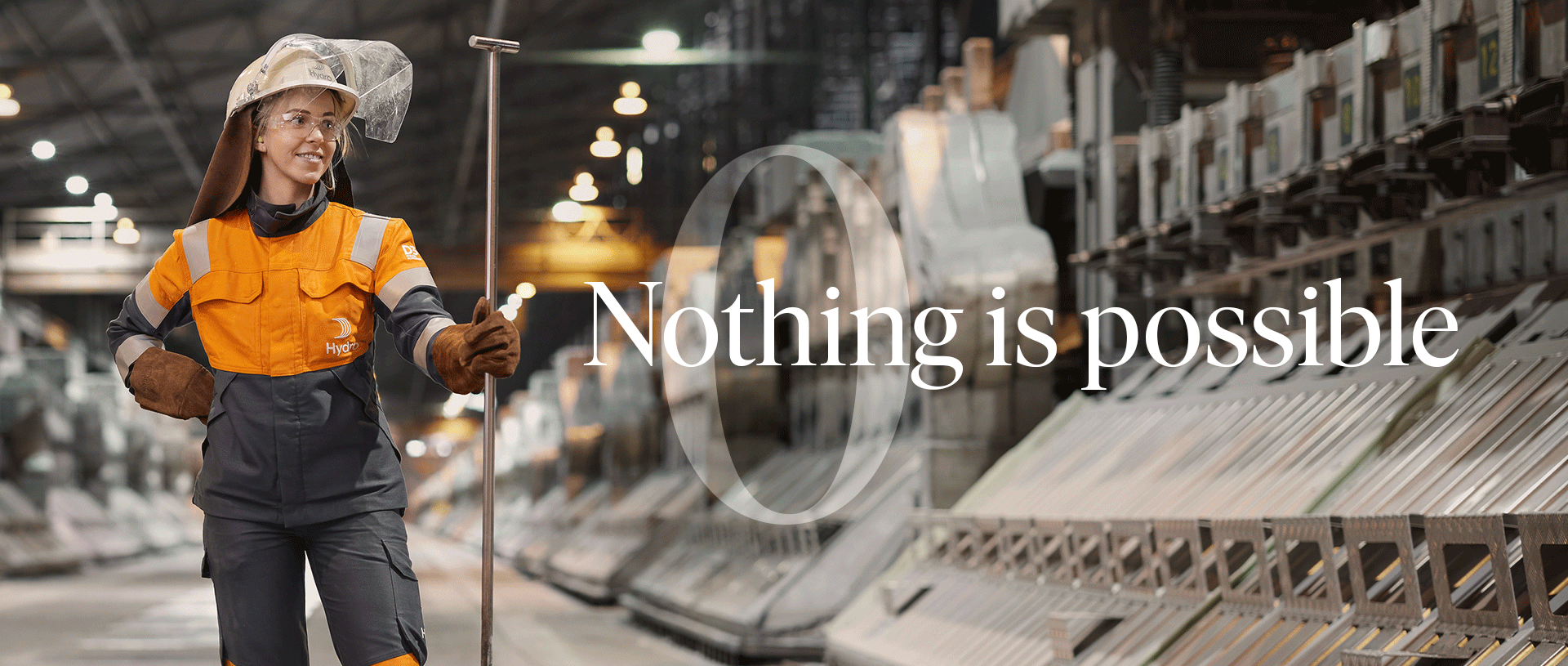The challenge of climate change transcends borders and industries. To reach the global targets set by the Paris climate agreement, we must collectively decarbonize energy systems, produce for circularity, and recycle resources already in use. Aluminium is a key enabler in the green transition, but production must become emission free across the entire value chain.
In a hard-to-abate industry like ours, we are determined to achieve zero emissions. By using a cleaner energy matrix based on renewables such as hydro, wind, and solar power, we're already delivering low-carbon aluminium to the world to decarbonize other key industries. In 2022, we produced our first batch of near-zero aluminium using 100% post-consumer scrap, with work now ongoing to optimize the production.
We are committed to a 30 percent reduction in our carbon emissions by 2030, with a goal of achieving net zero in Scope 1 and 2 carbon emissions by 2050. Hydro’s roadmap aims to create multiple pathways that can work together to help us reach near zero products today, and zero products in the future. Here’s how:
1. Recycling: Moving in circles

The fastest way to deliver zero-carbon aluminium is by recycling post-consumer scrap, which is aluminium that has lived a past life as beverage cans, windows, car parts, etc. With more than half of the aluminium we use being recycled in facilities all over the world, our advanced technologies increase the share of aluminium that can be sorted and repurposed.
Hydro is continuously exploring new possibilities to source post-consumer scrap that can be repurposed and given a new life. Through our Batteries Unit, we are able to source and recycle both the critical battery materials, but also harvest the aluminium frames that protect the battery packs. Those packs are dismantled at Hydrovolt, our battery recycling joint venture with Northvolt in Fredrikstad, Norway, and the aluminium is then transported and processed at our recycling plant in Årdal, Norway.
Hydro’s recycling operations consist of 27 recyclers and a sorting facility in Europe, United States and Canada for our Aluminium Metal and Extrusions business areas. The total capacity is approximately around 2 million metric tonnes per year.
Hydro is currently offering recycled aluminium products, which consists of 75% post-consumer scrap and has a product footprint of 2.3 kg CO2 /kg aluminium. Hydro’s recycling system can deliver near-zero carbon aluminium based on 100% recycled post-consumer aluminium scrap. Near-zero is defined as aluminium with a footprint of 0.5-1 kg CO2 /kg aluminium, throughout the value chain.
In Hydro, we believe our customers should know the actual footprint of recycled aluminium, not just the percentage of recycled content. This is the only way to support the circular transition. That’s why we calculate CO2 emissions in an honest and transparent way, where the emissions follow the metal and recycled content is only counted as zero-emissions when the scrap has been used by consumers, not just as industrial scrap from extrusion processes. This distinction between pre- and post-consumer scrap is one of many ways we are leading the way in transparent carbon footprint calculations. Learn more about how and why we calculate emissions this way in our No Time To Waste recycling white paper.
2. Carbon Capture: Capturing everything to achieve Nothing

Our aim is to retrofit our existing plants with carbon capture and storage, to capture 100 percent of gas and direct air emissions. Our ambition is to have an industrial-scale pilot running by 2030.
To speed up decarbonization of the aluminium industry and make our existing aluminium smelters fit for the future, Hydro is developing carbon capture and storage (CCS) solutions that can be retrofitted into aluminium plants that are in operation today. Hydro has evaluated more than 50 CCS technologies and developed a roadmap for testing and piloting the most promising ones up to industrial scale.
3. HalZero: A quantum leap on the path to zero

Hydro's HalZero is a key step towards zero-emission aluminium. This groundbreaking proprietary technology will fully decarbonize the smelting of aluminium, eliminating emissions from both electrolysis and anode baking, resulting in emission-free aluminium.
For six years, Hydro’s technology experts have worked to develop a breakthrough technology for primary aluminium production. The HalZero technology is based on converting alumina to aluminium chloride prior to electrolysis in a process where chlorine and carbon are kept in a closed loop where the only emission is oxygen. The results of the initial test phase are very promising, and we are now ready to start piloting the technology in lab scale. If successful, the ambition is to produce first pilot volumes by 2025 and to have an industrial-scale pilot up and running by 2030.
4. Cleaner energy matrix from the mine to the metal

Power is the most significant input in the aluminium industry and critical to meet global climate targets. To reduce emissions, aluminium must be produced using cleaner energy solutions like renewable power throughout the value chain. While Hydro's refinery in Brazil is transitioning to more sustainable fuel sources to mitigate emissions in upstream operations, our primary aluminium production in Norway is powered by 100% renewable energy. Globally, Hydro’s renewable energy share towers at over 70 percent.
Hydro Rein supports Hydro and other industrial companies to decarbonize through large renewables projects and energy efficiency or onsite power generation. The solar and wind projects in Brazil are some of the largest renewable energy sites under construction and are important enablers to decarbonize our refinery operations and reach Hydro’s target of a 30% CO2 reduction by 2030.
Currently, the refinery uses fuel oil as an energy source. We are replacing this with liquid natural gas. Not only will this help reduce our direct carbon emissions from energy use, but it will also help develop critical infrastructure that can benefit the entire region. The fuel switch project will reduce the refineries' annual GHG emissions by 700,000 tonnes. In addition, Hydro is planning to reduce emissions there by an additional 400,000 tonnes by 2025, through replacing coal fired boilers. The refinery is already positioned in the first quartile of GHG emission intensity and is 35 percent lower than the industry average. By 2030, the aim is to fully decarbonize all processes, except the calcination process.
Read more about the Fuel Switch Project in the Alunorte refinery.
Hydro is developing technology to replace natural gas with renewable energy in the form of electricity, biogas or green hydrogen for the casthouse furnaces, which requires further research and development. Hydro Havrand, our green hydrogen company, is coordinating a study to look at alternatives. The aim is to develop technology pilots by 2024, with the ambition to industrialize new technology by 2026.
Read more about Hydro Havrand
Hydro is not only targeting zero emissions but also reducing consumption. Since 2009, Hydro's researchers and engineers have worked to produce aluminium with the world's lowest energy consumption. Our latest development, the HAL4e technology, was a breakthrough and reduced energy consumption by 15 percent. It has been tested in a limited number of full-scale production cells and is enabling the most energy efficient primary aluminium production in the world.
Sustainability beyond zero
To achieve our vision of not just decarbonizing our operations but also influencing a broader societal shift, it's imperative to intensify our ambitions across all fronts.
Beyond advancing our technological capabilities, we're resolute in enhancing our positive impact across three key pillars:
- Climate
- Environment
- Society
This includes growing recycling capability and capacity to increase use of post-consumer aluminium scrap across our aluminium business.
Hydro is also setting new sustainability ambitions in the areas of environment and social responsibility. In environment, the ambitions include protecting biodiversity and reducing the environmental footprint.
Finally, Hydro’s social ambition is to improve lives and livelihoods wherever we operate. The existing target of empowering 500,000 people with education and skills development by 2030 is supplemented with business-specific targets to support a just transition, and ensure responsible business practices throughout Hydro’s supply chain, providing traceability and transparency of key sustainability data for Hydro’s products.
Updated: May 15, 2024
